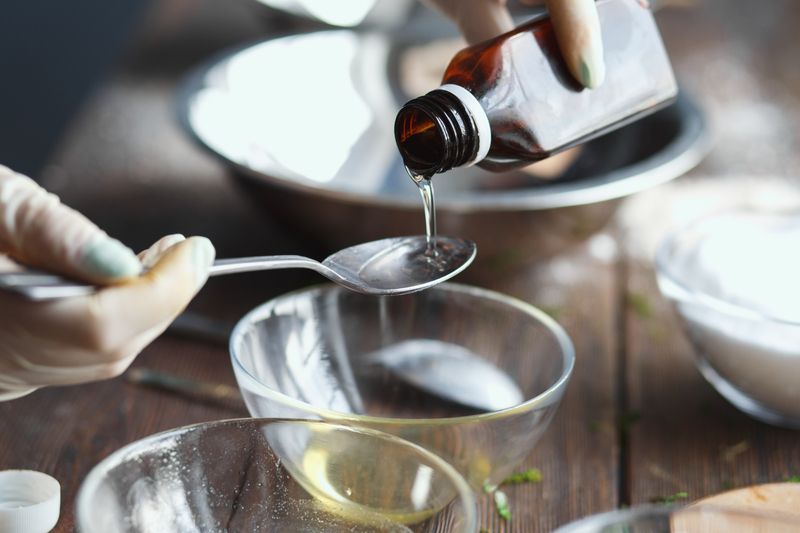Effective Burnt-on Residue Removal for a Gleaming Stovetop
Posted on 26/05/2025
Effective Burnt-on Residue Removal for a Gleaming Stovetop
Keeping your kitchen spotless is essential for a healthy home. However, burnt-on residue can easily spoil the pristine look of your stovetop. Whether you have a gas, electric, or glass cooktop, tackling stubborn messes can be challenging. This comprehensive guide will walk you through effective burnt-on residue removal methods and provide expert tips to ensure your stove always shines.
Understanding Burnt-on Residue
Burnt-on residue refers to the tough, often blackened, spills and food remnants that adhere tightly to your stovetop during cooking. Not only do they make your kitchen look untidy, but they can also harbor bacteria and unpleasant odors. Knowing the types of residues and how they form is the first step towards their efficient removal.
- Food spills - Accidents during cooking often lead to hardened layers of food on stovetops.
- Grease splatters - Fat and oil can splatter and become sticky, attracting dust and debris.
- Mineral deposits - Water spills can leave mineral marks, especially on glass stovetops.

Why Remove Burnt-on Residue Promptly?
Delaying residue removal can make cleaning more difficult and harm your stovetop's surface. Burnt-on stains can:
- Scratch and damage glass and ceramic cooktops.
- Damage heating elements if left on electric burners.
- Cause unpleasant smells in your kitchen.
- Attract bugs or bacteria.
For a kitchen that gleams and a stovetop that always looks new, routine cleaning is essential. The following sections cover effective burnt-on residue cleaning techniques for all stovetop types.
Supplies You Need for Burnt-on Residue Removal
Before starting your cleaning session, gather these items for the best results:
- Soft microfiber cloths or sponges
- Non-scratch scrubbers
- Plastic scraper or razor blade (for glass stovetops)
- Baking soda
- White vinegar
- Dish soap
- Store-bought stovetop cleaner (optional)
- Old toothbrush
- Protective gloves
General Method for Removing Burnt-on Residue
The following step-by-step routine works for most stovetops. Adjust based on your specific appliance's material.
- Let the stovetop cool - Safety first! Ensure your stove is completely cool before cleaning.
- Remove grates and burners (if applicable) - For gas stoves, lift off the grates and burner covers.
- Apply a soapy solution - Mix dish soap with warm water and soak a cloth or sponge. Place it on the burnt area for 10-15 minutes to soften residue.
- Sprinkle baking soda - Generously sprinkle baking soda over the damp residue. Gently scrub in circular motions with a damp non-scratch sponge.
- Use vinegar for tough stains - Spray or pour white vinegar over the baking soda, allowing it to fizz and break down the residue further.
- Scrape gently - For glass or ceramic tops, use a plastic scraper or razor blade at a 45? angle to carefully lift burnt-on material. Never use metal scouring pads, which can scratch!
- Wipe clean and dry - Use a clean, damp microfiber cloth to remove residue, then dry with a fresh towel for a gleaming finish.
Pro Tip
Always consult your stovetop's user manual for manufacturer-recommended cleaning techniques, especially for specialty surfaces.
Cleaning Methods for Different Stovetop Types
Each stovetop surface requires unique cleaning strategies to avoid damage while achieving a streak-free shine.
1. Glass and Ceramic Stovetops
Glass and ceramic cooktops offer a sleek, modern look but are particularly vulnerable to scratches. Try this approach for effective burnt-on residue removal:
- Sprinkle baking soda directly onto the cooled residue.
- Place a warm, damp towel over the area and let it sit for 10-20 minutes.
- Use a plastic scraper or razor blade (held at a shallow angle) to gently lift away softened debris.
- Wipe the area with a clean cloth and polish with a dedicated glass stovetop cleaner for extra shine.
2. Gas Stovetops
Gas stovetops have separate grates and burners that also accumulate burnt-on food. Use these steps:
- Remove grates and burners and soak them in hot, soapy water.
- Scrub with a non-abrasive brush or sponge. For stubborn spots, make a paste of baking soda and water, apply to stains, and let sit before scrubbing.
- Wipe the stove surface with vinegar for a streak-free finish.
- Dry grates thoroughly before reassembling to prevent rust.
3. Electric Coil Stovetops
Electric stove coils should not be soaked. Here's how to clean them safely:
- Unplug the coils and remove them from the stovetop.
- Wipe with a damp cloth and mild soap. For tough residue, gently scrub with a mixture of baking soda and water.
- Never submerge the coils; allow them to air dry completely before use.
Advanced Burnt-on Residue Removal Techniques
Sometimes, basic cleaning isn't enough. If you spot persistent, severely burnt-on residue that resists standard methods, try these professional tips:
Use a Commercial Stovetop Cleaner
Specialty products specifically designed for glass, ceramic, or metal cooktops can break down the toughest grime. Follow the manufacturer's instructions closely for safety and best performance.
Apply Baking Soda and Vinegar Paste
- Mix 1/2 cup baking soda with just enough vinegar to form a thick paste.
- Spread the paste on the residue and cover with a damp cloth. Let it sit for several hours or overnight.
- Wipe and rinse thoroughly for excellent results. Repeat if necessary.
Try Lemon Juice for a Natural Clean
- Cut a lemon in half and rub directly on stubborn stains. The acid helps break down carbonized residue and adds a fresh scent.
- Rinse with water and wipe dry.
Utilize a Steam Cleaner
A handheld steam cleaner can soften extremely hard, burnt-on food, making removal easier without harsh chemicals. Be sure the surface can handle moisture and heat before using this method.
Preventing Burnt-On Residue: Maintenance Tips
Prevention is always easier than cure! Keep your stovetop sparkling and drastically reduce cleaning time with these habits:
- Wipe up spills right away - Don't let food or liquids sit and bake onto surfaces.
- Use drip pans and liners - These catch overflow before it burns on.
- Clean grates and burners weekly - A regular schedule prevents build-up.
- Keep a spray bottle of vinegar solution nearby - Lightly mist and wipe each night for lasting shine.
Common Mistakes to Avoid When Cleaning Burnt-on Residue
Avoid damaging your stove and extending cleaning time by steering clear of these errors:
- Never use metal scouring pads - They will scratch and dull most stovetop materials.
- Don't use harsh chemicals indiscriminately - Some products can discolor or corrode surfaces.
- Avoid excessive water - Especially on electric and induction cooktops, as water seeps can harm electrical components.
- Don't neglect drip areas - Edge and corner spills can become impossible to remove if ignored.
Homemade Solutions for Eco-Friendly Stovetop Cleaning
If you prefer natural options, several household staples are remarkably effective for burnt-on residue removal:
- Baking Soda and Vinegar - The dynamic fizzing duo for gentle, effective cleaning.
- Lemon and Salt Scrub - Sprinkle coarse salt, rub with lemon, and let the citric acid lift burnt grime.
- Hydrogen Peroxide Paste - Combine with baking soda for stubborn discoloration (test on a small area first).
Frequently Asked Questions about Burnt-on Residue Removal
Can I use bleach on my stovetop?
No. Bleach is too harsh for most stove surfaces and can create toxic fumes when mixed with other cleaning products. Stick to mild detergents, vinegar, or dedicated stovetop cleaners.
How often should I deep clean my stovetop?
Deep cleaning is optimal every 1-2 weeks, depending on cooking frequency. Spot-clean spills as soon as they occur for minimal burnt-on residue build-up.
What's the safest way to scrape burnt-on material from glass stovetops?
Always use a plastic scraper or a razor blade held at a sharp angle to avoid surface scratching. Gently glide beneath the residue; never use force.
Do commercial stovetop cleaners work better than homemade solutions?
Many store-bought products are formulated for rapid, effective residue removal and may outperform DIY options for severe stains. However, natural remedies are inexpensive, readily available, and gentler on the environment.

Summary: Your Path to a Gleaming, Residue-Free Stovetop
Achieving a spotless, gleaming stovetop is simpler than you might think! Whether battling a minor spatter or heavy burnt-on accumulation, consistent care using these effective burnt-on residue removal techniques makes a world of difference.
- Always let the stove cool before cleaning.
- Use non-abrasive tools and mild, natural cleaners where possible.
- Treat all spills promptly and adopt a regular cleaning routine.
- Consult your appliance manual for specific care instructions.
By incorporating these proven methods, you'll ensure that your stovetop not only remains free of burnt-on residue but also looks as gleaming as the day you bought it. Keep your kitchen spotless, safe, and inviting with proper stovetop care!
Final Thoughts on Burnt-on Residue Removal
In summary, maintaining a sparkling stovetop doesn't require magic - just the right approach and a bit of elbow grease. With the techniques and tips shared above, effective removal of burnt-on residue is well within reach. Regular attention will keep your stove as the shining centerpiece of a clean, healthy kitchen.
*Ready to reveal that gleaming stovetop? Start today with these easy, proven residue removal techniques and enjoy cooking in a truly spotless kitchen!*





